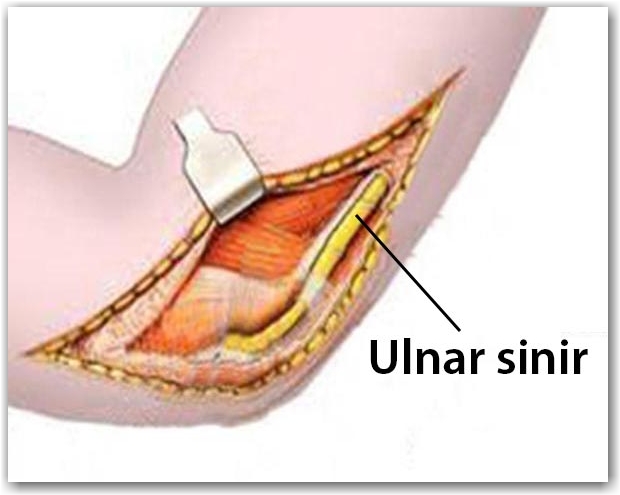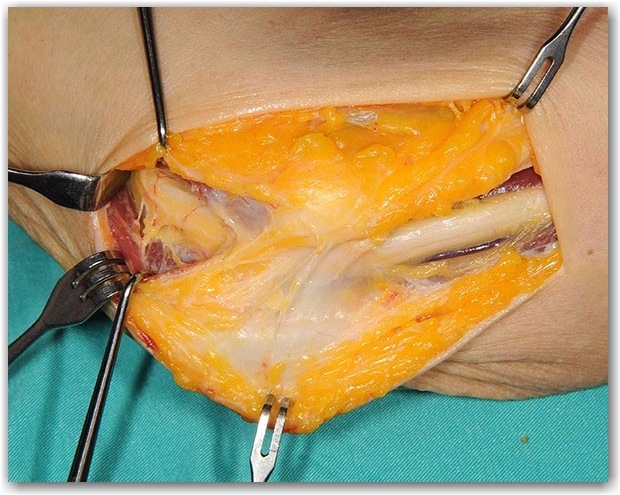What is Cubital Tunnel (Ulnar Groove) Syndrome?
Cubital tunnel syndrome is a clinical condition that is caused by compression of the so-called ulnar nerve in where a specific tunnel locates called the ulnar groove at the elbow level. The ulnar nerve passes under the bony prominence (medial epicondyle) on the inner side of the elbow. This tunnel where the nerve passes is called ulnar groove (cubital tunnel). Within this tunnel, the nerve is directly in close contact with the bone and joint capsule, and it tends to be compressed under pressure.
If the Nerve Gets Stuck in this Tunnel;
Clinical condition presents characterized by
- hand numbness
- pain and
- weakness
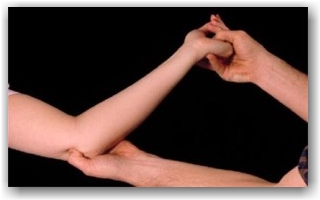
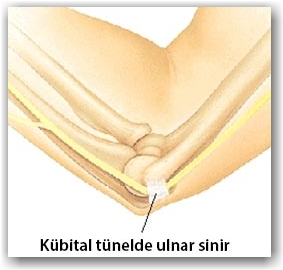
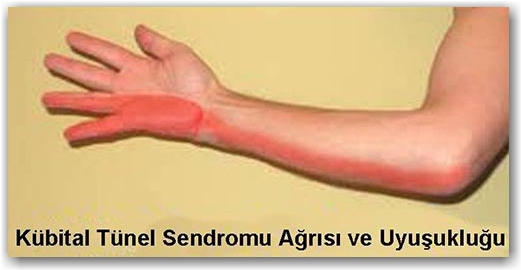
What are the Causes of Cubital Tunnel (Ulnar Groove) Syndrome?
This pressure on the nerve may increase with many reasons:
The nerve can be got stuck due to the fact that it is in a narrow tunnel with the bone under it and a very thick, hard protective layer on it. Because of these reasons, nerve may remain under pressure in office workers sitting in front of a table for a long time, in individuals whom their inner part of the elbows getting constant pressure or in persons who are working with keyboard in too close with the elbows in maximum bending position for a long time.
In some of patients, as the elbow bends and extends, the nerve can jump over the medial epicondyle calls snapping. If this creates a chronic condition, an irritation on the nerve may occur.
Sometimes the connective tissue covering the groove through which the nerve passes through the elbow can thicken and compress the nerve. If the pressure above the nerve exceeds a certain level and duration, the nerve function is impaired and cubital tunnel syndrome occurs.
What Are the Symptoms of Cubital Tunnel (Ulnar Groove) Syndrome?
The frequent complaints of patients are as follows:
- Numbness in the elbow, forearm, hand and / or fingers
- Tingling
- Pain
- Prickling and electricity
Numbness and tingling often occur in ring and small fingers. Complaints exacerbate if pressure increases over the nerve. Symptoms increase when you hold the phone, work with the keyboard in close to you for a long time, read a book or a newspaper with maximum elbow bending position, or sleep with staying bended elbow. Some patients feel weakness, point loosing dexterity in using their hands, and say that they drop some objects from their hands. In severe cases, complete lost of sensation in the fingers and atrophy of the muscles in the hand may also occur.
How to Diagnose the Cubital Tunnel (Ulnar Groove) Syndrome?
Your doctor examines both the sensory and motor functions of the ulnar nerve and understands whether there is a problem or not in the nerve conduction at the elbow level. The physician asks the existence of other general health status such as goiter or diabetes. If he/she suspects the presence of cubital tunnel syndrome, electromyography study (EMG) – nerve conduction test may be needed to reveal the condition and severity. This test is also useful for the differential diagnosis of other problems of nerves.
How to treat cubital tunnel (ulnar groove) syndrome?
– If the clinical condition is minor or in beginning, it is possible to reduce the complaints by taking care of the posture and position of the elbow during active daily living, not putting the elbow on the hard surfaces, and protecting the bony prominence (medial epicondyle) on the inner side of the elbow and the nerve by using various cushions and splints.
– Tension and the edema around the nerve can be reduced with various physical therapy modalities.
– Using a night splint may be useful if the nighttime complaints bother the patient because of extreme bending position of the elbow during sleep.
– If the complaints are advanced, or if all the conservative methods mentioned above do not work, releasing of the nerve can be performed by surgical methods. The thickened connective tissue covering the ulnar gutter is opened to release the nerve. Sometimes, relocating the nerve to a safer location may be needed. Surgery is usually an out-patient procedure. However, one-day hospitalization may be needed. After the surgery, the elbow usually dresses with a bulky bandage for 10-15 days, but patients can use their hands immediately. Twelve to 13 days after the surgery, stitches are taken out. For a few more weeks, heavy lifting, forcing, and power needed activities are not recommended. Physical therapy may be necessary. It is expected that the numbness and tingling will be resolved immediately after the operation. Strengthening of the hand may take time if there is already weak muscles or muscle loss before surgery.
Prof. Dr. Eftal Gudemez
Orthopedics and Traumatology
Hand Surgery and Microsurgery
